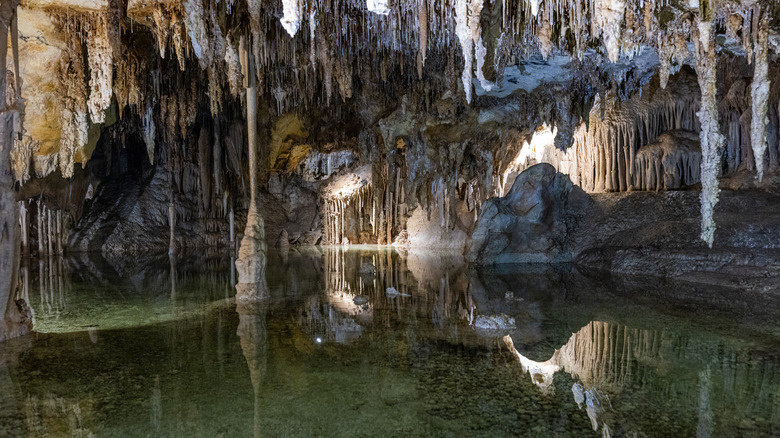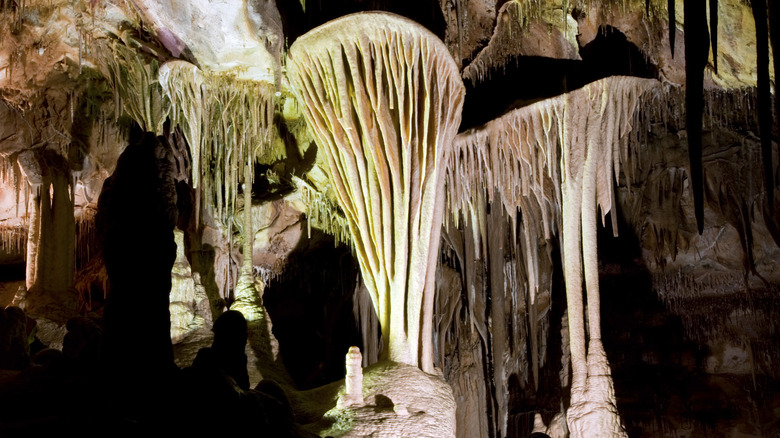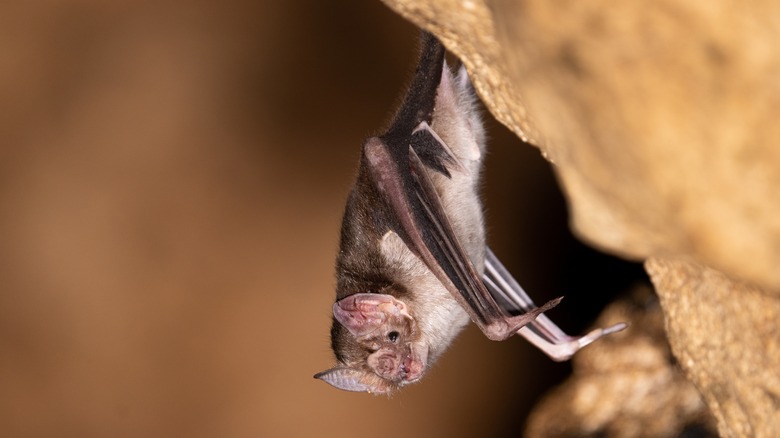Stalactites Create Glittering Formations In A Mesmerizing Nevada Cave
It was nearly two decades after settling in Snake Valley, Nevada, as a rancher in the 1860s when Absalom Lehman made a startling discovery close to his property. Some accounts say Lehman felt a cool breeze coming out of the ground, leading him to find the entrance to a spectacular cave system toothed with stalactites. Others say it was actually Lehman's horse that discovered the caves, accidentally breaking into the cave's entrance. What we know for certain is that around 1885, long before the area was designated a National Park, Lehman came upon these caves in the desert and began giving private tours, letting visitors see an underground wonder of nature that now carries his name.
Today, the Lehman Caves are located in Great Basin National Park, an underrated terrain with scenic drives and ancient pine trees. Serving as a gateway to the park is the funky town of Baker, Nevada. By car, you can get to the caves from Baker's center in about eight minutes. When visiting the caves, you can reserve a time slot for either a 30-minute, 60-minute, or 90-minute cave tour, year-round. The different tours cover different sections of the cave, areas that have been given whimsical names such as the Gothic Palace, the Inscription Room, and the Sunken Gardens. As you marvel at the natural architecture of these formations, you'll see why they're likened to majestic palaces.
The fascinating formations of the Lehman Caves
The Lehman Caves are really one massive cave made up of connected chambers and passageways that extend about 2 miles in total length. The cave is made from limestone rock formations, which were compacted 550 million years ago. Over time, acidic water that flowed into the cave through cracks dissolved parts of the rock, creating the cavities that now define the cave's chambers. One of the most unique events in the cave's formation — and what makes it such a geological wonder — is what's called the deposition of speleothems. This process occurs as water drips through limestone, depositing calcium that forms stalactites on the ceiling and stalagmites on the floor. Over the course of thousands of years, each drip of water has contributed to the cave's mesmerizing architecture.
Another unique element of the cave's make-up is the presence of cave shields — large saucer shapes that jut out from the cave's walls and ceiling. The Lehman Caves have over 500 cave shields, including the famous Parachute Shield, which a special Parachute Shield Tour highlights. Meanwhile, the Grand Palace Tour is the longest of the cave tours, taking visitors through sections including the Gothic Palace and the Music Room. Interestingly, the Music Room got its name because when Lehman first led tours of the cave, he allowed visitors to strike the stalactites and stalagmites, each reverberating a different note to create cave music. Of course, this isn't allowed today, and the park states that visitors can't touch the cave at all. You'll also be screened for White Nose Syndrome, which means that you can't carry any items that have been in other caves without first disinfecting them since this can expose bats to dangerous fungi.
Cave creatures and woodland wildlife
Cave ecosystems are a testament to nature's adaptability, thriving in near-total darkness. Some of the most intriguing inhabitants are troglobites, organisms that spend their entire lives in caves. These creatures have adapted to the darkness by losing their eyes and developing unique body shapes. In Lehman Caves, you might spot a Cave Pseudoscorpion, Springtails, or the Lehman Caves Millipede, a species found nowhere else on Earth. Townsend's Big-Eared Bats also call the caves home. Though they carry a somewhat bad reputation, bats are, in fact, essential to the ecosystem; they're the only major predator of moths and mosquitoes, and they even pollinate certain plants.
While you're in the area, it's also worth exploring the ecosystem of the Great Basin National Park. A short 0.3-mile loop trail from the Lehman Caves Visitor Center takes you through pinyon-juniper woodlands, which are teeming with life. Visitors often spot northern sagebrush lizards, kit foxes, and soaring ferruginous hawks as they wander the landscape. These woodlands are not only rich in biodiversity but also hold cultural significance for Native American tribes, who have harvested pinyon nuts here for generations. And, if you want to learn more about Nevada's Native history, you can see Native American rock art in the charming, artsy city of Henderson, located outside of Las Vegas.


